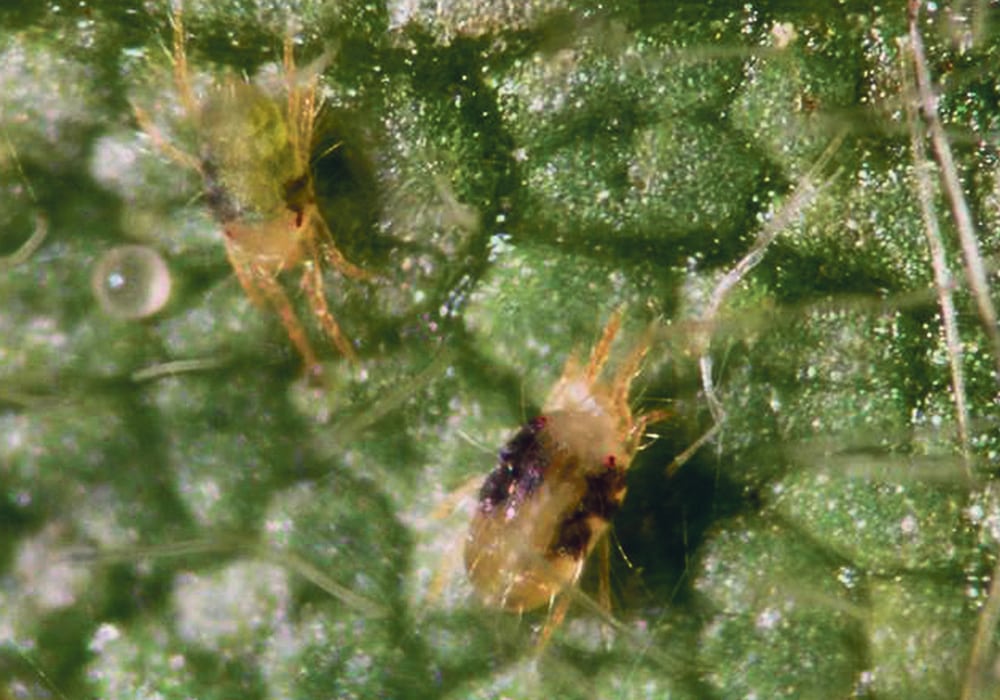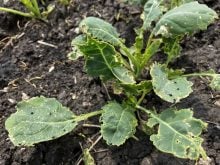Not a serious pest in most years, spider mites are rearing their tiny mouthparts this year because of dry conditions
Spider mites are making inroads into the Prairies and Plains and into the resident soybean crops.
In Manitoba, producers are noticing a higher presence of the plant-piercing pests this year. The tiny, less than half a millimetre long insects often move from ditches or earlier crops such as cereals to soybeans or dry beans and can injure enough leaves to cause significant losses under the right conditions.
Heavier rains or cooler August weather can limit the pests, but with this year’s heat and dry periods, they have been taking advantage of the environment to set up shop in Western Canada.
Read Also

Growing garlic by the thousands in Manitoba
Grower holds a planting party day every fall as a crowd gathers to help put 28,000 plants, and sometimes more, into theground
John Gavloski of Manitoba’s provincial agriculture department says the leaf-sucking pests can threaten yields in soybeans at the R4 to R5 crop stages.
“From that full pod size to when the seeds are filling stages are when the (two-spotted) spider mites will have the most impact on the yields,” he said.
“Once they are at R6, when full of seed or that green-bean stage, the spider mites will have less of an impact,” he said.
Deciding on a control threshold can be a challenge, said the entomologist.
He cites North Dakota recommendations that are based on University of Minnesota research.
“Sample plants at least 100 feet into the field and walk in a U-pattern, sampling two plants per location at 20 different locations. A general action threshold is to treat when heavy stippling on lower leaves with some stippling progressing into middle canopy; mites present in middle canopy with scattered colonies in upper canopy; and lower leaf yellowing common.”
After spotting the feeding damage of stippled leaves, producers can shake plants over a plastic plate or tray placed under the canopy to determine if mites are present.
That helps to determine if it is the mite that is doing the damage.
Dimethoate (Cygon or Lagon) is the only registered insecticide for spider mites in soybeans. It has a 30-day pre-harvest interval, meaning producers finding an issue in August need to control the pest as soon as possible to avoid harvest delays.
Dimethoate is highly toxic to mammals, birds, bees and other insects, so it should be applied when bees are not foraging and producers should wear respirators, goggles, boots and coveralls. It can be applied by air or ground rig.
The mites will also look for tender leaves to chew in other crops and can be a problem in alfalfa. For that, producers can turn to a more targeted insecticide, Oberon, which will have fewer non-spider mite casualties. However, producers should still avoid applying when pollinators are flying.
Malathion is also registered for the pest in alfalfa, clover, potatoes, dry beans and peas and is highly toxic to bees and other insects.
“You need to weigh the decision carefully about spraying. You can also end up killing the mites’ pests,” said Gavloski.
Because the insecticides that are registered for the mites also are effective on many other insects, this can allow spider mites to become a larger issue.
“And you can’t just go and use up some other products you have left out in the chemical shed,” he said.
“Many of them have less effect on the mites and can cause (the population) to flare.”
Synthetic pyrethroids can suppress spider mite activity but will have a greater effect on the predators of the mite. This is off-label and potentially create larger populations after application.
Producers should scout for the mites at the fields’ edges because the pests often move from other crops and are concentrated into those bands. This makes treating a lower-cost affair and limits the overall impact on other insects that are present elsewhere in the field.
The mites will tend to be resident on the underside of leaves, so high water rates, from 15 to 25 gallons per acre, and pressures above 40 pounds per sq. inch are most effective when spraying.
Because the spider mites are very short-lived and have many cycles in a growing season, a single application might not provide complete control. As a result, producers are encouraged to scout fields a week to 10 days after application to ensure the problem hasn’t re-emerged from previously laid eggs.
Higher humidity and rainfall support fungal pests of the mites.
“So conditions can change quickly,” said Gavloski.

















